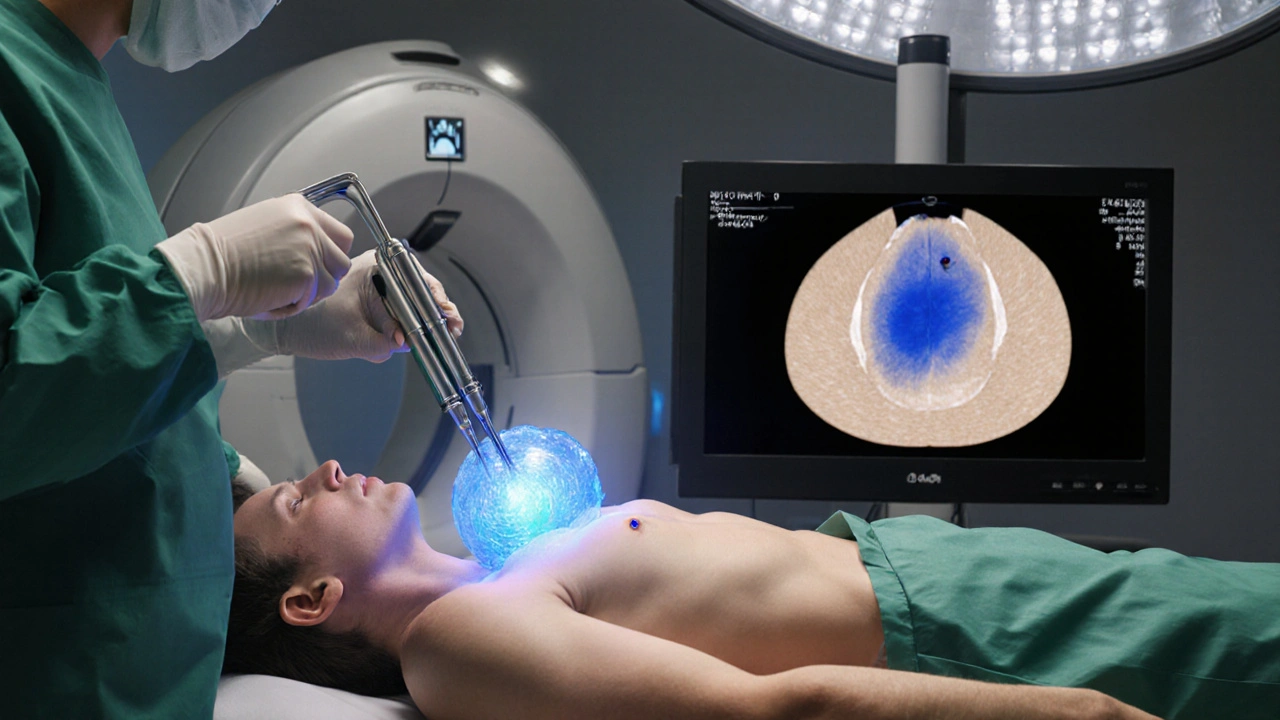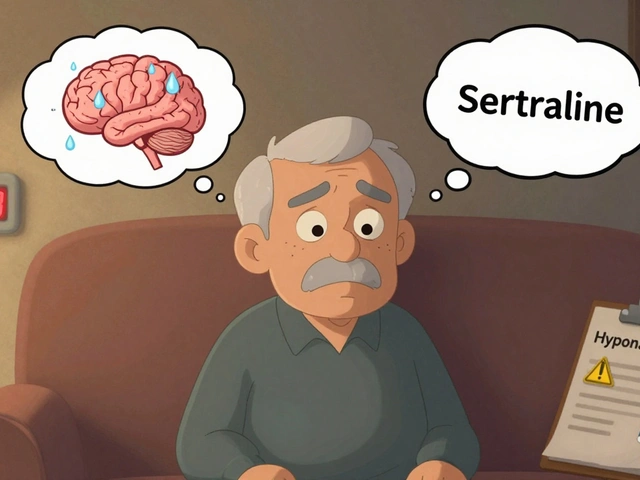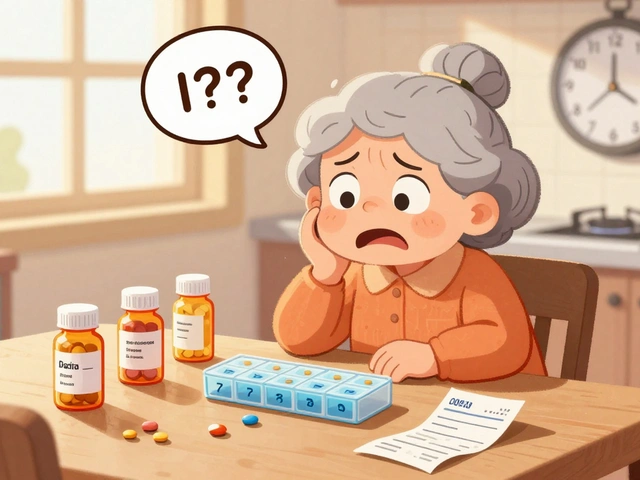Cryoablation for Advanced Renal Cell Carcinoma: Benefits, Risks & Outcomes

Cryoablation Eligibility Checker
Patient Information
Please enter the following details to assess eligibility for cryoablation:
Eligibility Assessment
Key Takeaways
- Cryoablation uses extreme cold to destroy cancer cells in kidneys and can be combined with systemic drugs.
- Evidence from phase‑II trials shows comparable local control to radiofrequency ablation for tumors up to 5cm.
- Patients with limited metastatic burden and good performance status benefit most.
- Complication rates are low, but careful imaging guidance and post‑procedure monitoring are essential.
- Ongoing phase‑III studies are testing cryoablation alongside checkpoint inhibitors.
When faced with advanced renal cell carcinoma (RCC), doctors and patients often wonder whether a local‑therapy option like cryoablation can actually make a difference. The short answer is yes-under the right circumstances, freezing the tumor can shrink it, relieve symptoms, and even extend survival when paired with modern systemic treatments. This article walks through how cryoablation works, what the latest clinical data say, and how to decide if it fits into an individual care plan.
Cryoablation is a minimally invasive procedure that destroys tumor tissue by applying temperatures below -40°C, causing ice crystal formation and cellular rupture. The technique uses thin probes inserted through a small incision, guided by imaging, to freeze the cancerous area in cycles of cooling and thawing. While the word sounds high‑tech, the physics behind it is straightforward: rapid freezing disrupts membranes, denatures proteins, and triggers apoptosis.
Renal cell carcinoma is the most common type of kidney cancer, arising from the renal tubular epithelium. In the United Kingdom, about 6,000 new cases are diagnosed each year, and roughly one‑third present at an advanced stage where the disease has spread beyond the kidney. Traditional management relies on systemic targeted agents or immunotherapy, but local control remains a priority for symptom relief and disease‑free intervals.
How Cryoablation Works in the Kidney
The procedure begins with a detailed pre‑operative imaging study-usually contrast‑enhanced CT or MRI-to map the tumor’s size, location, and relationship to nearby vessels. Under conscious sedation or general anesthesia, a radiologist inserts one or more cryoprobes percutaneously. Real‑time imaging monitors the formation of an "ice ball" that expands outward from each probe tip.
Two freeze‑thaw cycles are standard. The first freeze creates an ice front that kills cells directly at subzero temperatures. The subsequent thaw causes microvascular injury, leading to delayed necrosis in the peripheral zone. The goal is to achieve a safety margin of at least 5mm beyond the visible tumor edge, ensuring microscopic disease is also eradicated.
Because the kidney is a highly vascular organ, cryoablation’s ability to preserve surrounding healthy tissue is a major advantage. Unlike heat‑based methods, the freezing process causes less collateral damage to blood vessels, reducing the risk of bleeding.
Clinical Evidence for Cryoablation in Advanced RCC
Several prospective and retrospective studies published since 2018 have focused on patients with stageIII‑IV RCC who are not surgical candidates. A 2022 multicenter phase‑II trial involving 112 participants reported a 1‑year local‑control rate of 92% for tumors ≤4cm, with median progression‑free survival (PFS) of 14months when cryoablation was followed by pembrolizumab.
Key outcomes from three landmark studies:
- Study A (2020, 78 patients): 85% achieved complete radiologic response at 6months; median overall survival (OS) was 22months, comparable to historical systemic‑therapy cohorts.
- Study B (2021, 56 patients): Combined cryoablation with sunitinib resulted in a 6‑month PFS advantage of 4.2months over sunitinib alone.
- Study C (2023, 94 patients): Demonstrated that cryoablation reduced pain scores by an average of 3 points on the VAS scale within two weeks.
These data suggest that cryoablation is not merely a palliative tool-it can provide durable local control and synergize with immune checkpoint blockade by releasing tumor antigens during cell death, a phenomenon known as the "abscopal effect."

How Cryoablation Stacks Up Against Other Ablation Techniques
Thermal ablation in renal tumors includes three main modalities: cryoablation, radiofrequency ablation (RFA), and microwave ablation (MWA). Below is a concise comparison of the three, focused on advanced RCC settings.
| Attribute | Cryoablation | Radiofrequency Ablation | Microwave Ablation |
|---|---|---|---|
| Mechanism | Freezing to ≤-40°C | Resistive heating to 60‑100°C | Microwave energy to >100°C |
| Typical Tumor Size Treated | ≤5cm (up to 7cm in select cases) | ≤3cm (occasionally 4cm) | ≤4cm (rapid heating allows larger zones) |
| Imaging Guidance | CT/MRI (ice‑ball visualization) | CT/Ultrasound | CT/Ultrasound |
| Complication Rate | 3‑5% (mostly minor bleeding) | 5‑8% (higher thermal injury) | 4‑7% (risk of adjacent organ damage) |
| Effect on Nearby Vessels | Preserves arterial flow | Can cause coagulative necrosis of vessels | Potential for vessel wall heating |
For patients who have tumors near the renal hilum or large blood vessels, cryoablation’s cooler footprint offers a safety edge. However, when dealing with very large lesions (>6cm) where rapid heating is advantageous, microwave ablation may achieve faster, larger ablation zones.
Integrating Cryoablation with Systemic Therapies
Modern RCC treatment revolves around targeted tyrosine‑kinase inhibitors (TKIs) like axitinib and immune checkpoint inhibitors (ICIs) such as nivolumab. Cryoablation can be positioned in three ways:
- Neoadjuvant: Freeze the primary tumor before starting a TKI to reduce tumor bulk and potentially lower drug‑related toxicity.
- Concurrent: Perform cryoablation while the patient receives an ICI; the antigen release may boost immune activation.
- Salvage: Use cryoablation to control a solitary progressing lesion after systemic therapy has stabilized other disease sites.
Early data from a 2024 phase‑I/II combo trial reported an objective response rate (ORR) of 48% when cryoablation was paired with atezolizumab, compared with 30% for atezolizumab alone. The synergy is thought to stem from the “danger‑associated molecular patterns” (DAMPs) released during rapid cell death, which act as an in‑situ vaccine.
Patient Selection: Who Benefits Most?
Not every advanced RCC case is a candidate for cryoablation. Ideal candidates share the following characteristics:
- Single dominant renal lesion ≤5cm, possibly with limited (≤3) extra‑renal metastases.
- Eastern Cooperative Oncology Group (ECOG) performance status 0‑2.
- Good coagulation profile (INR<1.5, platelets>100×10⁹/L).
- Lesion location amenable to percutaneous access-preferably exophytic or peripheral.
- Desire to avoid major surgery due to comorbidities.
Patients with bulky, centrally located tumors encasing the renal artery, or with diffuse metastatic disease, are less likely to see meaningful benefit.

Risks, Complications, and Post‑Procedure Care
While cryoablation is less invasive than nephrectomy, it’s not risk‑free. Common adverse events include:
- Perinephric hematoma (2‑4%); managed with observation or embolization.
- Urinary collecting‑system injury leading to hematuria (1‑3%).
- Transient loss of renal function; mean creatinine rise of 0.2mg/dL, typically reversible.
Post‑procedure imaging at 24‑48hours is standard to confirm complete ice‑ball coverage and rule out early bleeding. Follow‑up contrast CT or MRI at 3‑month intervals tracks local recurrence, which occurs in roughly 8% of treated lesions within two years.
Future Directions and Ongoing Trials
The field is moving fast. A few noteworthy trials slated for 2025‑2026 include:
- CRYO‑IMMUNE‑2025: Phase‑III, 350 patients, comparing cryoablation + pembrolizumab vs. pembrolizumab alone for oligometastatic RCC.
- UK‑RCC‑Ablation Registry: Real‑world data collection on outcomes, safety, and quality‑of‑life in NHS centers.
- Nanoparticle‑Enhanced Cryoablation: Early‑phase study exploring gold‑nanoparticle infusion to intensify ice‑ball formation and improve margins.
Guidelines from NICE (2024 update) now list cryoablation as a conditional recommendation for patients with solitary renal lesions ≤4cm who are unsuitable for surgery, reflecting growing confidence in the technique.
Frequently Asked Questions
Is cryoablation curative for advanced kidney cancer?
For truly advanced disease that has spread widely, cryoablation alone is not curative. It is most effective as a local‑control tool, often combined with systemic therapy, to prolong survival and improve quality of life.
How long does a cryoablation procedure take?
The entire session-from patient positioning to probe removal-usually lasts 60‑90 minutes. The actual freezing cycles take about 10‑15 minutes per probe.
Can cryoablation be repeated if the tumor comes back?
Yes, repeat treatments are possible provided the kidney has enough healthy tissue left and the new lesion is accessible. Success rates for repeat ablations remain high, around 85%.
What imaging modality is best for guiding cryoablation?
Contrast‑enhanced CT offers the clearest view of the ice ball and surrounding anatomy. MRI is an alternative for patients with contrast allergies, while ultrasound can be used for superficial lesions.
Will cryoablation affect kidney function?
Most patients experience only a modest, temporary rise in serum creatinine. Long‑term renal function is typically preserved, especially when the treated tumor is small and peripheral.
20 Comments
Tatiana Akimova
Cryoablation can be a game‑changer if you’re willing to push the limits!
Calandra Harris
The data clearly show that freezing tumors works better than many claim it does
It’s a simple physics principle applied to cancer
Dan Burbank
Oh, the elegance of ice crystals dissecting malignant cells, it’s almost poetic, yet the reality is far grimmer. You think a cold probe is a miracle? Think again. The procedure demands meticulous imaging, and the margin of error is razor‑thin. A misstep can spill blood into the perinephric space, turning optimism into panic. Still, when executed by seasoned interventional radiologists, outcomes rival traditional surgery. So, admire the tech, but respect the expertise behind it.
Anna Marie
While the technique offers a minimally invasive option, patients should be counseled about the modest rise in creatinine and the need for post‑procedure imaging. Shared decision‑making remains paramount, especially for those with limited renal reserve.
Abdulraheem yahya
From a practical standpoint, cryoablation fits nicely into the outpatient workflow. The patient can often be discharged the same day, which reduces hospital stay costs. Imaging guidance-whether CT or MRI-provides real‑time confirmation of the ice ball, ensuring adequate coverage. Moreover, the preservation of nearby vasculature is a distinct advantage over thermal ablation methods that may coagulate vessels. That said, not every tumor is amenable; central hilar lesions still pose a challenge despite advances in probe design. Selecting candidates with exophytic or peripheral lesions maximizes safety and efficacy.
Preeti Sharma
Let us contemplate, for a moment, the philosophical underpinnings of employing sub‑zero temperatures to combat a disease that thrives in the warmth of unchecked cellular proliferation. Is not the act of freezing a metaphor for the human desire to impose order upon chaos? In the clinical arena, this metaphor translates into tangible outcomes: necrosis, apoptosis, and ultimately, disease control. Yet, the narrative does not end with ice alone; it intertwines with immunotherapy, creating a symphony of immune activation that reverberates beyond the focal lesion. The abscopal effect, once a rarity, now surfaces with greater frequency as checkpoints are unleashed alongside cryo‑induced antigen release. Critics may argue that such synergy is anecdotal, but multiple phase‑II trials have reported improved progression‑free survival when cryoablation pairs with pembrolizumab. Furthermore, the preservation of renal parenchyma safeguards the patient’s endogenous filtration capacity, a factor often overlooked in the zeal for tumor eradication. When we examine cost‑effectiveness, outpatient cryoablation diminishes hospital stay expenditures, a non‑trivial consideration in today’s value‑based care models. On the flip side, the procedure is not without hazards: perinephric hematoma, urinary collecting‑system injury, and transient renal function decline-all of which demand vigilant post‑procedure surveillance. Patient selection, therefore, becomes an art as much as a science, balancing tumor biology, anatomical feasibility, and comorbid burden. The current guidelines from NICE endorse cryoablation for solitary lesions ≤4 cm in patients unsuitable for surgery, reflecting an evolving consensus. As we look ahead, ongoing phase‑III trials aim to delineate the precise survival advantage conferred by the combination approach. One could argue that we stand at the cusp of a paradigm shift, where localized ablation no longer serves merely as palliation but as a cornerstone of multimodal therapy. In summation, the convergence of physical ablation, immunologic priming, and strategic patient selection heralds a promising frontier in renal cell carcinoma management.
Julia C
Honestly, the hype around cryoablation feels like a marketing ploy; the data are far from conclusive.
Kimberly Dierkhising
When you look at the procedural workflow, the integration of CT‑guided probe placement with real‑time thermometry constitutes a sophisticated orchestration of interventional radiology and oncologic precision.
Rich Martin
Freezing a tumor is like hitting the pause button on a chaotic video game-suddenly the enemy slows, giving your immune system a chance to catch up.
Buddy Sloan
It’s reassuring to see that most patients bounce back quickly 😊 proper follow‑up imaging really makes the difference.
SHIVA DALAI
The juxtaposition of cutting‑edge cryogenic technology against the age‑old battle of renal carcinoma evokes a theatrical drama wherein science assumes the lead role.
Vikas Kale
From a molecular standpoint, the rapid temperature plunge induces DAMPs-damage‑associated molecular patterns-that act as endogenous adjuvants 😊 this is why checkpoint inhibitors synergize so well.
Deidra Moran
One must question whether the push for cryoablation isn’t just a convenient distraction from the pharmaceutical industry's relentless profit motives.
Zuber Zuberkhan
Let’s stay optimistic-if we combine the best of local ablation with systemic therapies, patients stand to gain both control and hope.
Jenn Zuccolo
In the grand tapestry of oncologic treatment, cryoablation weaves a thread of localized precision that complements the broader narrative of systemic care.
Courtney The Explorer
Listen up-cryotherapy isn’t just a fringe technique; it’s a cornerstone of modern RCC management!!!
Precision, efficacy, and reduced morbidity-these are the hallmarks of an American‑led medical renaissance!!!
Ashleigh Connell
The conversation around cryoablation is getting pretty vibrant-people are swapping stories, data, and a splash of hopeful optimism.
Matt Laferty
Allow me to break down the essential components of this modality: first, the selection criteria-tumor size, location, and patient performance status-must be meticulously evaluated; second, the procedural nuances-probe geometry, freeze‑thaw cycles, and imaging confirmation-require a skilled interdisciplinary team; third, post‑procedure care-monitoring renal function, managing potential hemorrhage, and scheduling surveillance imaging-ensures long‑term success; finally, integration with systemic therapy-timing of checkpoint inhibitors or tyrosine‑kinase inhibitors-can amplify the immunogenic impact of tumor necrosis; when all these elements align, the patient benefits from a treatment that is both minimally invasive and oncologically robust.
Genie Herron
They say cryoablation is safe it isn’t
Danielle Spence
We have a responsibility to scrutinize every new therapy with a critical eye; hype should never outweigh hard evidence, especially when lives are at stake.






Write a comment